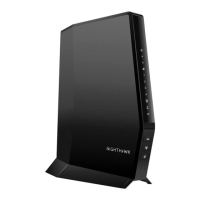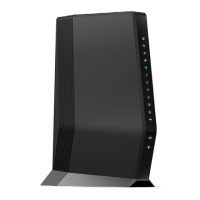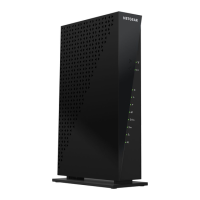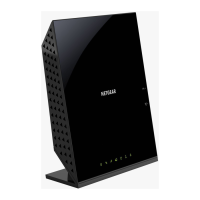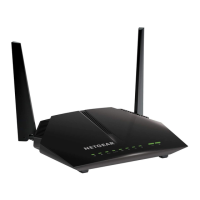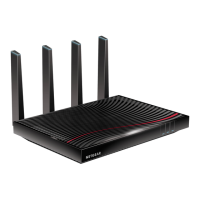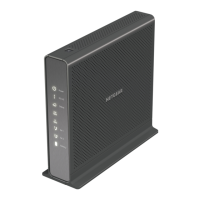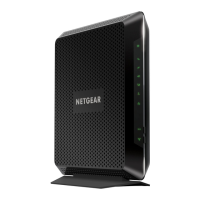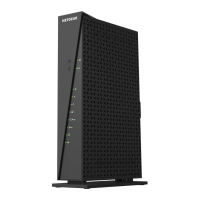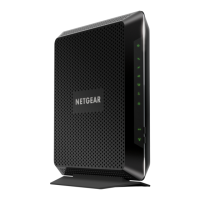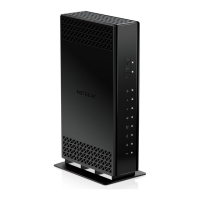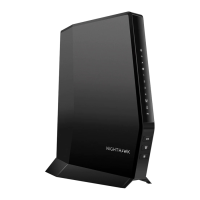
Do you have a question about the NETGEAR CAX30 and is the answer not in the manual?
| WiFi Standard | Wi-Fi 6 (802.11ax) |
|---|---|
| DOCSIS Standard | DOCSIS 3.1 |
| USB Ports | 1 x USB 3.0 |
| Max Download Speed | Up to 2.5Gbps |
| Wi-Fi Bands | Dual-band (2.4GHz and 5GHz) |
| Processor | 1.5 GHz quad-core |
| Compatible ISPs | Xfinity, Spectrum, Cox |
| Security | WPA3 |
| Weight | 1.6 lb (0.73 kg) |
| Ethernet Ports | 4 x Gigabit Ethernet |
Information on how to get help, register products, and contact support.
Lists NETGEAR trademarks and mentions other trademarks.
Information on regulatory compliance and visiting a website.
Instructions for unpacking the modem router and its contents.
Details about status LEDs and buttons on the front of the modem router.
Shows and describes the connections and buttons on the rear panel of the modem router.
Guidelines for optimal placement of the modem router for WiFi signal coverage.
How to connect the modem router to a computer for setup.
Instructions and information needed to activate internet service.
How to test internet speed and what to do if it's lower than expected.
How to set the starting frequency for the cable connection.
Tracking the modem router's initialization and provisioning process.
Steps to manually configure internet connection settings.
Adjusting the Maximum Transmission Unit size for network performance.
Instructions for wired and WiFi connections to the modem router.
Explains different types of logins for the modem router.
Steps to access the modem router's web interface for configuration.
Setting up rules to allow or block devices from accessing the internet.
Blocking specific websites or domains using keywords.
Blocking specific internet services based on type or schedule.
Removing previously blocked keywords from the list.
Exempting specific computers from internet blocking rules.
Managing lists of allowed or blocked devices using ACLs.
Setting up schedules for blocking internet access to sites and services.
Configuring email alerts for router activity and security events.
Configuring Wide Area Network settings for internet connectivity.
Configuring a DMZ server to improve compatibility with certain applications.
Renaming the router for easier identification on the network.
Adjusting local network IP configuration and RIP settings.
Configuring the range of IP addresses the router assigns via DHCP.
Turning off the router's DHCP server to use an external one.
Assigning static IP addresses to specific devices on the LAN.
Simplifying WiFi connection setup using Wi-Fi Protected Setup (WPS).
Configuring fundamental WiFi settings like SSID and security.
Selecting the operational mode for WiFi bands (2.4GHz and 5GHz).
Adjusting WiFi transmission power to manage coverage and power usage.
Modifying the WiFi network's password and security protocol.
Creating a separate WiFi network for guests with customized settings.
Enabling or disabling WiFi radios using buttons or the web interface.
Scheduling when WiFi signals are turned on or off.
Configuring settings related to Wi-Fi Protected Setup (WPS).
Controlling implicit beamforming for improved WiFi signal.
Managing airtime fairness for equitable WiFi resource distribution.
Combining Ethernet ports to increase file transfer speed.
Setting up internet port aggregation for multi-gigabit speeds.
Checking for and installing new firmware for the router.
Modifying the router's administrator login password for security.
Setting up a system to recover the admin password if forgotten.
Steps to recover the router's admin password using security questions.
Accessing details about the router's status and network configurations.
Viewing real-time data on port usage, traffic, and status.
Verifying the router's current internet connection status and IP details.
Reviewing logs of network activity, blocked access, and events.
Listing all devices connected to the router's network.
Tracking and controlling internet data volume and connection time.
Backing up, restoring, or erasing router configuration settings.
Enabling access to the router's settings from outside the local network.
Customizing the router's LED behavior for reduced distraction.
Configuring the router's time zone for accurate logging and scheduling.
Specifying the Network Time Protocol server for accurate time synchronization.
Configuring the router as a DLNA media server for media playback.
Resetting the router to its original factory settings.
Details on supported USB drive file systems and compatibility.
Steps for physically connecting a USB storage device to the router.
How to access USB storage from Windows PCs using network shares.
Assigning a drive letter to a USB storage device for easier access in Windows.
How to access USB storage from Mac computers via network shares.
Using ReadySHARE Vault software for automatic backups from Windows computers.
Utilizing Time Machine for backups from Mac computers to USB storage.
Allowing File Transfer Protocol (FTP) access to USB storage on the local network.
Browsing shared folders and details of connected USB storage devices.
Creating new shared folders on a USB storage device.
Modifying settings for existing network folders on USB storage.
Proper procedure for disconnecting USB storage devices to prevent data loss.
Configuring Dynamic DNS services for remote network access.
Enabling external File Transfer Protocol (FTP) access to USB storage.
Setting up a personalized FTP server using Dynamic DNS.
Methods for accessing USB storage remotely via the internet.
Using ReadyCLOUD for remote file access to USB devices connected to the router.
Establishing a virtual private network connection to the router.
Configuring the router to use a specific VPN service and settings.
Installing OpenVPN client software on various devices for VPN access.
Creating a VPN tunnel from a Windows computer to the router.
Accessing USB storage and media on the router via a VPN connection.
Routing internet traffic through the home network via a VPN connection.
Setting up rules to allow specific incoming internet traffic to reach local servers.
Dynamically opening ports based on outbound traffic for specific applications.
Provides basic troubleshooting steps and sequences for common issues.
Interpreting LED indicators to diagnose router status and problems.
Steps to resolve issues preventing login to the router's web interface.
Troubleshooting steps when the router is connected but internet access fails.
Resolving issues with loading web pages or accessing the internet.
Steps to ensure configuration changes are saved correctly in the router.
Diagnosing and fixing problems with connecting to the WiFi network.
Using the ping utility to test network connectivity and diagnose issues.
Lists the default configuration settings of the router after a reset.
Provides detailed technical data about the modem router's hardware and capabilities.
